by Hannah Slater & Grace Tremonti | Nov 27, 2023
Coming into medical school, we knew we wanted to make an impact in the University of Michigan Medical School (UMMS) community by following our passion for improving equity, representation and inclusion. One student group that particularly caught our attention was the Student Diversity Council (SDC), which works to ensure the medical school community promotes diversity, equity, inclusion, accessibility and justice (DEIAJ). SDC also works closely with the administrators to amplify student voices in various medical school decisions.
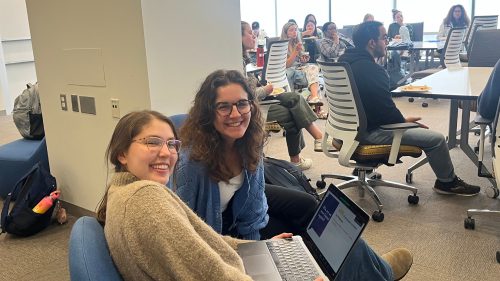 Following a small group discussion in the medical student lounge (also known as the Slounge), we discovered our mutual interest in diversity promotion. We reached out to the leadership team of SDC hoping to find a way to make an impact, specifically how we might be able to help improve our M1 curriculum. We were shocked and thrilled by how receptive SDC was to our ideas and passion for improving DEIAJ in the curriculum and how they welcomed us with open arms. Every member of SDC comes to the group with their own personal motivations and ideas for initiatives, so we felt we had a lot of support and resources to help us enact our own project!
Following a small group discussion in the medical student lounge (also known as the Slounge), we discovered our mutual interest in diversity promotion. We reached out to the leadership team of SDC hoping to find a way to make an impact, specifically how we might be able to help improve our M1 curriculum. We were shocked and thrilled by how receptive SDC was to our ideas and passion for improving DEIAJ in the curriculum and how they welcomed us with open arms. Every member of SDC comes to the group with their own personal motivations and ideas for initiatives, so we felt we had a lot of support and resources to help us enact our own project!
Our first project centered around patient presentations in the Scientific Trunk, the first year of pre-clinical studies at UMMS. Patient presentations are sessions where real patients tell their story and answer questions directly from students. While patient presentations during the Scientific Trunk served as opportunities to learn about the pathophysiology of disease, we found that students wanted to hear more about the impact of socioeconomic status, race and ethnicity on the patients’ health and journey through the health care system.
We worked alongside Hana Murphy, a fourth-year medical student, to conduct a survey to assess students’ thoughts about diversity in patient presentations. The overwhelming opinion from students was that they wanted to hear more from patients of diverse backgrounds, including representation of different race, ethnicity, gender, socioeconomic status, sexuality, educational status and ages. We brought the results of the survey and ideas for strategies to improve patient presentations to the Scientific Trunk faculty. We discovered the Office of Patient Experience, a department within Michigan Medicine that integrates patient perspectives by sharing their stories with the goal of maintaining and strengthening a patient-centered culture of care.
Our idea was to incorporate videos of patient stories from the Office of Patient Experience website into the Scientific Trunk. As a team, we went through each video and designated which part of the curriculum each story would best supplement. This helped contextualize the pathophysiology of specific disease processes with real-life patient experiences with more varied backgrounds. With the help of Scientific Trunk faculty, we were able to begin to more officially integrate these resources into the M1 curriculum.
As we progressed through our M1 year and the M2 clinical year rapidly approached, we began to think about how we could continue to incorporate values of DEIAJ into our education. Hana shared an experience she had prior to her emergency medicine clerkship where Dr. Marcia Perry, Assistant Professor and Associate Chair for Diversity, Equity and Inclusion in the Department of Emergency Medicine, and Dr. Samantha Chao, PGY-4 in Emergency Medicine, discussed strategies to minimize bias in clinical notation. She thought that the messages from their talk could be incredibly valuable to students before they entered the clinical setting, and we agreed.
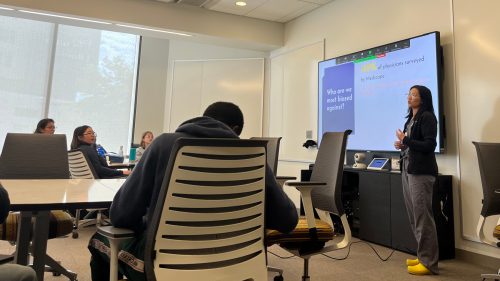
Dr. Chao presenting at the lunch event.
SDC hosted “The Power of Language in Clinical Documentation,” a lunch event to incoming M2s led by Drs. Perry and Chao. They led an interactive discussion about their experiences in the Emergency Department and their process of writing and presenting patient information while minimizing bias in their care teams. We looked at examples of notes with biased language and how it might influence providers’ perceptions of patients. They provided us with strategies to advocate for patients as medical students, acknowledging that we are in a position where we might not always feel empowered to correct a resident or attending. These strategies included changing progress notes to remove stigmatizing language and add person-centered phrasing. Other strategies included using the correct language during presentations on rounds, even when other providers might be using biased language.
In just two months of being clinical students, we are already able to put what we learned into practice. After inheriting a patient who had been through many medical services, his “one-liner,” the very first sentence anyone reads about them when looking through his medical chart, described the patient as a “drug abuser.” Changing the one-liner from “drug abuser” to “patient with a substance use disorder” was a small but tangible action toward reducing bias in the clinical space.
While clerkships take a lot of our time, our projects are still ongoing. As we traverse the clinical space, we are mindful of our current experiences and how they will inspire us to take action in the future. If you are reading this and are similarly passionate about DEIAJ work and want to have an impact, please consider working with or supporting the efforts of SDC!
by Kennedy S. Miller | Oct 26, 2023
After attending Second Look at Michigan (SL@M), it was clear that the University of Michigan Medical School was the place for me to pursue my medical education. However, the beginning of my medical school journey was bittersweet.
As it is for many matriculants, I had spent most of my life working towards becoming a physician, but I found myself not wanting to leave the life I had built for myself in DC. I was passionate about my work at the DC Primary Care Association (DCPCA) and had fallen in love with DC’s culture and pace of life. Collaborating with DC’s Federally Qualified Health Centers was immensely fulfilling, and I was sad to leave my projects, especially the initiatives that aimed to improve the holistic wellbeing of DC’s underserved patients.
Moreover, I had never lived in Michigan before, and I wasn’t sure where to start when it came to learning about the health infrastructure of my new community. I was intimidated by the prospect of starting over, both personally and professionally, in a new place. Crazily enough, it was a chance bus ride to West Ann Arbor that put my worries to rest and helped me get involved with the community health work that I hoped to continue upon moving to Michigan.
On June 16th, my best friend and I drove a U-Haul stuffed to the brim with everything I own from DC to Michigan. I moved here a couple months before starting school because I knew that I would need time to settle into my new life. For me, a huge part of feeling at home in a new place is exploring my community, so I made it a point to take public transit and visit different community gathering spaces around town. Some early-July day, while taking the bus to one of Ann Arbor’s district libraries, I happened to sit directly across from an advertisement for the Corner Health Clinic. It was a vibrant flier, with lots of playful icons and smiling faces. It stated that the clinic was a community health center that provided primary care to young folks in the Ypsilanti community. The flier also listed the clinic’s services, and two caught my attention: the community pantry and gender-affirming care.
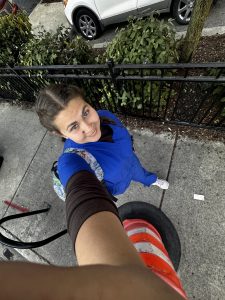
A commemorative selfie to celebrate my first shadowing experience as a medical student.
Fortuitously, the clinic manifested in my life again a few weeks later, when Dr. Emad Abou-Arab, who happens to work at Corner Health Clinic one day a week, came to speak with the LEAD cohort about practicing medicine after the pandemic. During his talk, he spoke about his passion for community health. He described how difficult it is for physicians to operate within the strict, arbitrary confines that insurance imposes on the provision of health care. He shared with us some of the strategies he uses to work around these issues and improve his patients’ ability to access care. Dr. Abou-Arab exemplifies the kind of physician and advocate I hope to become, so I reached out to him and asked if I could shadow him at Corner Health. He agreed and said he was excited to have me join him in the clinic. I took the bus over to Ypsilanti and we spent the morning seeing patients.
Genevieve Mulligan, a fourth-year medical student applying into family medicine, was also at the clinic that day as part of her clinical rotations. At the beginning of the day, Dr. Abou-Arab invited Genevieve to “run the show.” I accompanied Genevieve to the patient room and observed her perform the interview. It was inspiring to see Genevieve ask insightful questions and invite the patients to speak on all aspects of their health. Genevieve has an incredible passion for family medicine and is a generous peer mentor and teacher, who fervently shared her knowledge with me. After concluding the patient interview, we then returned to the office, reported our findings to Dr. Abou-Arab, and developed a preliminary course of action, making sure to consider the patient’s unique circumstances. All three of us then entered the patient room to collaborate with them to finalize the treatment plan.
Though I have been interested in gender-affirming care for many years, this was my first real clinical experience with this branch of medicine. It was rewarding to see how relieved and excited the patients were to be receiving hormone replacement therapies. It was amazing to see that Ypsilanti community members could not only get their primary care needs addressed at the clinic, but also receive life-saving treatments that have historically been withheld (and, in some states, continue to be) from patients. It was also meaningful to think about the impact that receiving these treatments would make on the patients’ emotional wellbeing on a daily basis. Unfortunately, identities are frequently forced upon us. Holding identities that aren’t readily apparent to others can be painful because society places us in boxes that don’t always match the ones that we would choose for ourselves. For this reason, there is indescribable power in reclaiming one’s ability to define their own selves and impact how they are perceived by those around them. I am glad that places like the Corner Health Clinic exist because every time that a patient who is transitioning takes a dose of their medication, they are moving forward in their journey to embodying the person who they know themselves to be.

Volunteering at the Packard Health Fair, another community health opportunity I’ve gotten the chance to be a part of since becoming a medical student at UMMS.
After we finished seeing patients, Genevieve and I went to the bottom floor of the clinic, where the community pantry is housed. It offers healthy foods, baby clothes, toiletries, and basic household necessities for free to Ypsilanti’s youth. While working at DCPCA, I learned that medical care alone does not make a significant impact on a patient’s health if their basic needs, like housing, food, and safety, are not being met. Therefore, health care providers must consider these external determinants of health and provide wraparound care and integrated resources that work beyond patients’ medical needs to ensure their physical and emotional wellbeing. In-house services like the clinic’s community pantry help do exactly that.
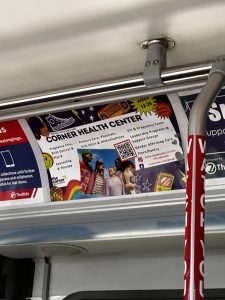
The ad that I saw for the first time in July and again on my way home from shadowing Dr. Abou-Arab at the Corner Health Clinic.
At the end of the morning, I thanked Dr. Abou-Arab and Genevieve for their time and enthusiasm for helping me learn. I got on the bus back to Ann Arbor and upon taking my seat, I saw something colorful out of the corner of my eye. You wouldn’t believe me if I told you that I found myself sitting across from the very Corner Health Clinic flier that I had seen on my bus ride to the library in July.
The word that best encapsulates my time so far at UMMS is serendipity. Though it was hard to leave DC, a series of chance interactions have catapulted me into incredible opportunities that make me feel as though I am exactly where I am supposed to be, and I am grateful for that.
by Aasma Hossain | Oct 5, 2023
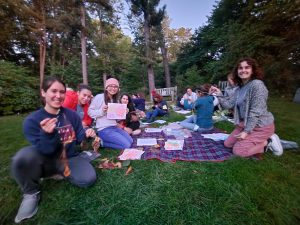 MedART is a longitudinal art therapy class for medical students at the University of Michigan that creates a space for discussion and creative expression. The program was founded in March 2022 by a group of friends looking to meaningfully reflect upon and convey their experiences in medical school. This is a course created by medical students for medical students. We found a need to provide a long-term creative outlet for processing the unique experiences that medical students encounter, and the novel emotions that our peers face with limited time and resources to share and understand them.
MedART is a longitudinal art therapy class for medical students at the University of Michigan that creates a space for discussion and creative expression. The program was founded in March 2022 by a group of friends looking to meaningfully reflect upon and convey their experiences in medical school. This is a course created by medical students for medical students. We found a need to provide a long-term creative outlet for processing the unique experiences that medical students encounter, and the novel emotions that our peers face with limited time and resources to share and understand them.
The course started off with the idea of making art more accessible to medical students as a means to relieve stress and promote well-being. The University of Michigan Medical School has several amazing events and workshops dedicated to promoting well-being through the arts. However, we felt there was a gap between having a space where students interested in the arts could really delve into it regularly, and providing an environment where they can feel safe to be vulnerable and have access to the creative medium. We decided to bridge this gap by introducing our peers to art therapy.
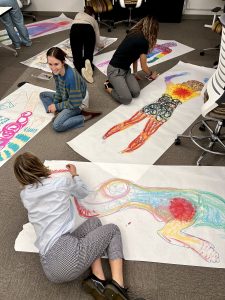 The MedART Therapy course comprises eight sessions, led by our amazing art therapist, Dr. Katherine Munter, whose passion and dedication has been invaluable. The course focuses on topics such as grappling with perfectionism, body image, imposter syndrome, processing trauma, and reclaiming one’s identity as an individual through color theory, surrealism, tactile art, resourceful art, “anabolic” and “catabolic” art, and cultivating art from nature. Different from other art-based wellness programs that emphasize the visualization of art, MedART Therapy approaches healing and rejuvenation through the creation of art.
The MedART Therapy course comprises eight sessions, led by our amazing art therapist, Dr. Katherine Munter, whose passion and dedication has been invaluable. The course focuses on topics such as grappling with perfectionism, body image, imposter syndrome, processing trauma, and reclaiming one’s identity as an individual through color theory, surrealism, tactile art, resourceful art, “anabolic” and “catabolic” art, and cultivating art from nature. Different from other art-based wellness programs that emphasize the visualization of art, MedART Therapy approaches healing and rejuvenation through the creation of art.
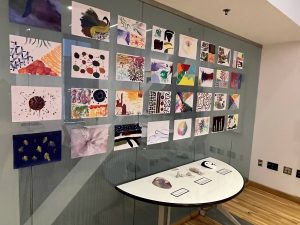 This notion of “process art” is core to our mission of empowering students, through art, to reframe personal struggles as opportunities for exploration, discovery and reflection. Students have found this course to provide an opportunity “to not be perfect, to be silly, to make friends, and to be mindful of what is going on around [them]”, and “learn to be more introspective… [using] different mediums to explore emotions and thought.”
This notion of “process art” is core to our mission of empowering students, through art, to reframe personal struggles as opportunities for exploration, discovery and reflection. Students have found this course to provide an opportunity “to not be perfect, to be silly, to make friends, and to be mindful of what is going on around [them]”, and “learn to be more introspective… [using] different mediums to explore emotions and thought.”
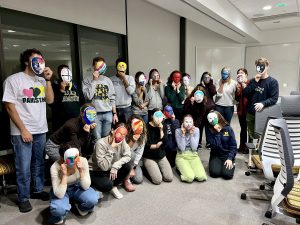 Due to the success of the course last year, we have brought it back this fall and hope to establish it as a permanent elective available to medical students in the future. Today, MedART is a supportive community of learners spanning different cohort years, backgrounds, and interests who are all on this very outlandish journey we call medical school.
Due to the success of the course last year, we have brought it back this fall and hope to establish it as a permanent elective available to medical students in the future. Today, MedART is a supportive community of learners spanning different cohort years, backgrounds, and interests who are all on this very outlandish journey we call medical school.
Special thanks to Dr. Joel Howell, Dr. Thomas Sisson, the Department of Internal Medicine, the Learner’s Wellbeing Office, and everyone involved in creating and establishing this course.
by Maya Hammoud | Sep 25, 2023
Wilderness Medicine is easily the most unique rotation I’ve done in medical school. Run by the Department of Emergency Medicine, Wilderness Medicine teaches students how to provide quality medical care in outdoor settings with limited resources, while also offering immersive experiences in backpacking, rock climbing, caving, and more! Join me as I take you through my past month on this interesting and exciting rotation.
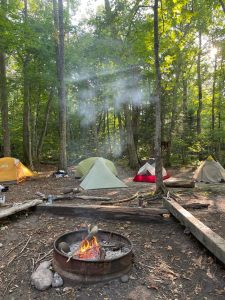
Camping at Pictured Rocks.
In the first week, we jumped right in with outdoor activities and lectures, interactive patient cases that may arise in the wild, a mass casualty simulation event, and orienteering. We learn by listening, but also by doing. Class is fun, engaging, and interactive.
The next week, we backpacked through Pictured Rocks in northern Michigan. The week was filled with beautiful experiences in nature, long hikes, daily “fireside chats” where students educate the group on a topic of their choosing, swimming in Lake Superior, learning to obtain and filter water in the wild, and, of course, camping at a new site each day. By the end of the week, we had developed a strong sense of comradery and accomplishment having backpacked 43 miles together through hot weather at first, then cold and rainy weather, all while fighting off blisters and mosquitos. Despite the struggles at times, the beauty of the nature around us, the freedom of being “unplugged” from phones and social media, and the independence of traveling by foot with all of our food, shelter, and supplies contained in backpacks provided a spectacular and unforgettable experience.
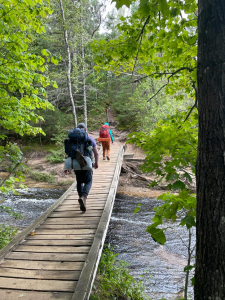
Backpacking at Pictured Rocks.
We had less than a week before our next trip, but in that time we managed to squeeze in kayaking, attending regional wilderness medicine rounds, mountain biking, and daily lectures.
Our next trip, and frankly my favorite part of the course, included rock climbing in Kentucky and caving in Indiana. I, along with several of my classmates, had never done either of these activities before, but we soon learned that we were to be led by experts and could make remarkable progress with no prior experience necessary!
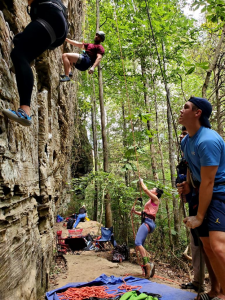
Climbing and belaying at the Red River Gorge.
We rock climbed in the Red River Gorge in Kentucky, a beautiful spot with thousands of natural rock walls of various heights and difficulty levels. It was great trying out the different climbs and watching our experienced resident leaders – Matt and Carlos – climb the more difficult rock walls. It was especially inspiring to see classmates who had a fear of heights overcome these fears and ascend multiple climbs! Climbing by day, we spent the evenings camping at Miguel’s and eating dinner at local spots in the small town of Slate, Kentucky.
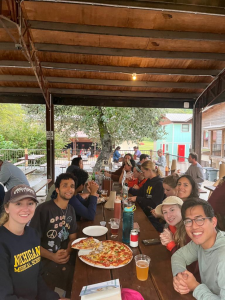
Dinner at Miguel’s.
After two eventful days of climbing, we drove up to Buckner Cave in Indiana. Here, we learned about and experienced exploring a “wild cave,” led by expert cavers Anmar and Jess. At times, the cave was barely a foot and a half tall, necessitating belly crawling or rolling to move forward. In other spots, we climbed up or down narrow passages, navigated around obstacles, or, rarely, were able to walk through open spaces.
We learned tricks to avoiding hypothermia in caves (hint: it involves a contractor bag and a candle!), medical considerations for evacuating patients from caves, and basic geology on how and why caves form. We also had a moment where everyone turned off their headlamps and sat perfectly still so we could meditate in the pitch-black darkness and perfect silence that is unique to caves. We debriefed and celebrated this unique experience with smores and hot dogs around the campfire on our last night camping together as a group.
The following day, having explored the cave once, we did a simulated evacuation of a “patient” (one of our classmates) from the cave. It required extensive teamwork and coordination, but we managed to carry our classmate out on a “litter” (similar to a stretcher) through all of the obstacles and tight spaces of the cave to safety.
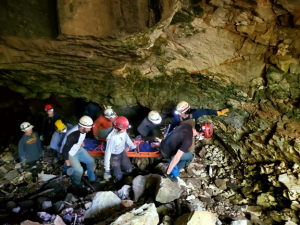
Extricating our “patient” from the cave.
After a team lunch, we drove back to Ann Arbor where we would finish up the course with a series of evidence-based medicine talks and a final exam of both written questions and scenario-based stations. Each student gave a talk on a wilderness medicine topic of their choosing, from managing obstetric emergencies in the wilderness to things that can go wrong while scuba diving or summiting mountains to the efficacy and importance of bug spray and sunscreen in the wild. We learned from each other, as we had throughout the course, both inside and outside of the classroom.
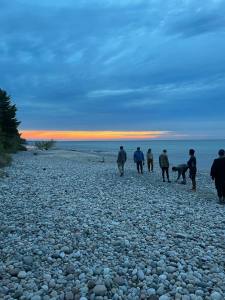
Sunset on Lake Superior.
As I reflect on the past month, I am in awe of how many new and unique experiences I have had in such a short span of time, as well as by the wealth of knowledge I have acquired on such a wide variety of wilderness medicine topics. Watching the sunset on Lake Superior, camping under the stars, scaling large rock walls in Kentucky, and exploring a cave 80 feet underground in Indiana were experiences my classmates and I will never forget. I wholeheartedly recommend this course for any student or prospective student whether or not they plan to pursue a career in wilderness medicine. I am so grateful for the amazing opportunity this course provided, as well as for the incredible resident and faculty leaders that made it happen.
by Lena Juratli | Aug 21, 2023
“I will erase my knees, I will eat it [my knees]…so that I will not kneel to an aggression, an army, or an era” – Muhammad Al-Maghout
سأمحو ركبتي بالممحاة , سآكلها .. حتى لا أجثو لعسكر أو تيار أو مرحلة. – محمد الماغوط
This profound quote originates from my late grandfather, the renowned Syrian poet and playwright, Muhammad Al-Maghout. His fearless exploration of contentious themes, deeply rooted in the socio-political context of the Arab world, alongside an unwavering dedication to Arab identity, social progress, and human rights, continues to resonate with modern thinkers and activists, solidifying his role as a transformative figure in Arab culture and intellectual discourse.

Me (left) and Noor Alesawy (right), one of Medical Arabic’s native speakers and a current master’s student at John Hopkins University.
Inspired by my grandfather’s enduring legacy, I embarked on my own transformative journey during the Branches – the inception of Medical Arabic in fall of 2022. As a University of Michigan medical student, I am resolute in upholding the values of justice, freedom, and human rights that he championed. This purpose is particularly resonant in southeast Michigan, where the state ranks as the second-largest haven for Arab Americans nationwide. The Detroit Metro Area, historically a magnet for Arab refugees and immigrants due to its vibrant automotive industry, encapsulates this cultural dynamism. It’s within this backdrop that Medical Arabic was developed, an innovative platform uniting over 700 healthcare professionals from across the United States in their pursuit of Arabic language proficiency.
This endeavor was born from my reflections on experiences with Arabic-speaking patients during my clinical year, including the unique challenges they faced in accessing healthcare. During my Step 1 study period, a flexible four-week window provided by the University of Michigan’s Medical School, I spent early mornings and late nights creating materials and worksheets to facilitate the language learning process, connecting with Middle Eastern and Arabic Language faculty at University of Michigan, and developing an innovative curriculum that would be feasible to run. I aimed for every student who joined Medical Arabic to forge a bridge—a bridge that transcends language, connecting hearts, healing communities, and uplifting the voice of every patient, regardless of the language they speak.
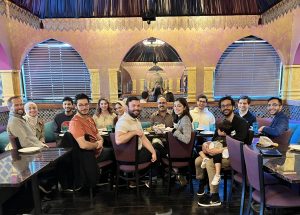
The executive board’s welcome lunch with our faculty advisors.
I actively sought perspectives from a diverse array of ethnic and religious groups who share Arabic as a common tongue, ensuring their meaningful representation within the framework of the Medical Arabic curriculum. This encompassed connecting with Egyptian Copts, Moroccan Jews, and Sudanese Christians, among other communities. I aspired to infuse the very essence of cultural richness and representational equity into the tapestry of the Medical Arabic curriculum through this spirited amalgamation of voices. I delved deep into the intricacies of medical education, the dynamics of healthcare leadership, and the intricately woven art of rallying support from a diverse community for a cause that had long remained overlooked and underrepresented.
Guided by the mentorship of Dr. Shahzad Mian, Dr. Emad Abou-Arab, and Professor Ibrahim Khalaylih, who have exhibited exceptional dedication to nurturing medical trainees at the University of Michigan, we seamlessly integrated healthcare perspectives into our content. Bringing this project to fruition required the collective effort of a diverse executive board, spanning multiethnic, multilingual, and multireligious backgrounds. Comprising medical, pharmacy, and dental students alongside undergraduates, this dynamic group worked together to meticulously craft curriculum and create content for our upcoming fall language workshops. With financial support from the Office of Multi-Ethnic Student Affairs, Dr. Abou-Arab’s Office for Health Equity and Inclusion grant, and the Gorenflo award from the Department of Family Medicine, our alliance rapidly drew together over 400 participants in just three months.
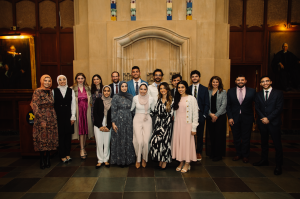
The executive board at our first annual Ramadan iftar.
Over the past year, we’ve organized a series of 12 language sessions catering to a range of skill levels. These sessions were complemented by culturally enriched seminars, drawing insights from Arab history, literature, and traditions. By integrating references to historical events, notable figures, and cherished cultural practices, we aimed to instill a deep sense of pride in Arab heritage. Our discussions ventured into essential themes, including Arab immigration trends in southeast Michigan, their influence on healthcare, barriers to healthcare screening, and more.
I created partnerships across campus, such as with Kellogg Eye Center’s Culture Committee, to host Arabic in Ophthalmology sessions. The impact was significant, drawing over 90 participants from Kellogg’s faculty and staff – a testament to the potency of language in creating bridges of understanding.
Our dedication to the community found expression through actions that extended beyond traditional boundaries. A poignant example is our initiative to provide free iftar meals to fasting healthcare professionals during Ramadan. This innovative endeavor marked a pioneering step at the University of Michigan, and its significance is further supported by its inclusion in a manuscript currently under review in a medical journal. In line with our partnership with El Harissa, I advocated for the donation of a portion of sales from the iftars to the Delonis Center, a local shelter that annually provides essential services and emergency shelter to approximately 1,200 individuals. Collaborations with local bookstores, like Literati in Ann Arbor, have allowed us to explore the significant literary works of Arab leaders, including a late winter book talk on the Syrian refugee experience. On a national stage, we proudly sponsored the 2023 Global Surgical Innovation Conference in Ann Arbor, advocating for equitable surgical care access in underserved regions worldwide.
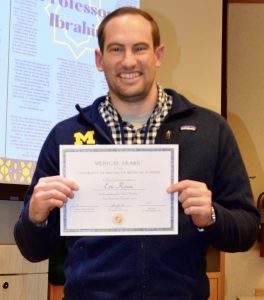
My classmate, M4 Eric, receiving his completion certificate.
Similar to Al-Maghout’s literary creations encompassing poetry, drama, and prose that advocated justice, freedom, and human rights, the core of Medical Arabic is grounded in the pursuit of these very ideals. Our movement operates as a conduit for unity and awareness, resonating with the transformative power of language. Through each interaction and connection we cultivate, Medical Arabic dismantles barriers, igniting impactful change.
As I reflect on these endeavors, a common thread of purpose emerges – a commitment to fostering connections, sparking change, and making a meaningful impact. Each collaboration and initiative supports the potential for transformation that lies within collective effort. In my medical career ahead, I carry forward this spirit, armed with the belief that purposeful actions, no matter how small, can create ripples of positive change that extend far beyond our immediate surroundings.
by Mustapha Jaber | Aug 17, 2023
Following my first year at the University of Michigan Medical School, I had the absolute privilege of being one of the four Health Equity Interns in the American Academy of Family Physicians (AAFP) Underrepresented in Medicine Health Equity Internship Program.
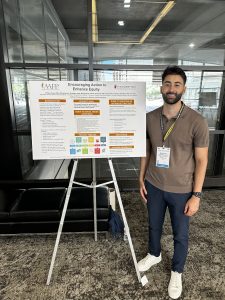
Presenting my work on the Social Determinants of Health Screening Action Guide at the AAFP National Conference in Kansas City, MO.
Throughout the summer, I engaged in learning about policy and commission making in healthcare. From the start, I had the honor of attending the Commission on Diversity, Equity, and Inclusiveness in Family Medicine, providing me an early vantage point to delve into health policy and witness the decision-making process shaping our healthcare landscape. Meeting leaders from around the nation and engaging with their expertise and perspectives on crucial issues left me enlightened.
One of the hallmarks of the internship program was the “Mentorship Mondays,” which afforded us the opportunity to meet and learn from Family Physicians from all around the country. It was amazing to meet inspirational physicians doing such diverse and impactful work. I left each meeting feeling empowered and inspired.
Additionally, to supplement our learning during the program, we were given a book called “The Political Determinants of Health” written by Daniel E. Dawes. This book was very insightful, providing an intricate dive into the forces and systems that have resulted in the disparities in health we see throughout history that are ever much present today. One of the major lessons I learned from reading this book, as well as our discussions with physicians, was the multitude of levels in which health disparities exist and conversely can be addressed. Starting from the individual patient encounter all the way to political structures, in order to properly address the health inequities we see today, we must have a comprehensive approach at all levels.
The core of the internship centered around developing action guides to improve the foundation of patient care and address social factors beyond the walls of the clinic. My role involved developing a guide to assist family physicians in identifying and addressing patients’ social needs. At first, I could not believe I would be working on such an important and impactful guide that would be used by family physicians across the entire country! I was equally excited and nervous to play such a pivotal role.
After a deep dive into the existing literature, it became apparent to me just how critical this guide will be. Did you know that clinical care is estimated to account for about 20% of health outcomes, whereas social determinants of health affect up to 50% of health outcomes (Hood CM)? The more I learned, the more I developed the guide by tailoring information to what seems to be most important for patients whose needs are not being met. Through introspection, I gained invaluable insights into my role as a future physician and what patient-centered care truly means.
Embarking on this uncharted process was inherently difficult, but I had the utmost privilege of being mentored by Dr. Margot Savoy. Our discussions and her unwavering support empowered me to visualize what I wanted the guide to be and the lasting impact I wanted to make. Her guidance encouraged us to take the lead and express our thoughts freely. This allowed me to write about my personal perspective on what is truly important to me and to the communities I deeply care about.
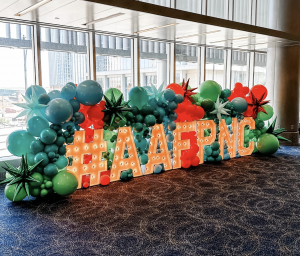
Photo Credit: American Academy of Family Physicians Instagram: (the_aafp)
In the midst of the program, I had the opportunity to travel to Kansas City, Missouri, and present an overview of the Social Determinants of Health Screening action guide at the AAFP National Conference! The conference was a transformative experience that opened my eyes to the critical work passionate individuals are doing across the world. I was able to attend discussions, listen to congressional reforms and network with peers from around the world. I could not help but feel a profound sense of purpose and commitment to my role in driving healthcare reform.
I am proud and honored to be a part of such an incredible and transformative program. I hope to take all the skills and knowledge I have gained thus far and use them throughout my career and to continue to be an agent of change.
References: Hood CM, Gennuso KP, Swain GR, Catlin BB. County Health Rankings: Relationships Between Determinant Factors and Health Outcomes. Am J Prev Med. 2016 Feb;50(2):129-35. doi: 10.1016/j.amepre.2015.08.024. Epub 2015 Oct 31. PMID: 26526164.
 Following a small group discussion in the medical student lounge (also known as the Slounge), we discovered our mutual interest in diversity promotion. We reached out to the leadership team of SDC hoping to find a way to make an impact, specifically how we might be able to help improve our M1 curriculum. We were shocked and thrilled by how receptive SDC was to our ideas and passion for improving DEIAJ in the curriculum and how they welcomed us with open arms. Every member of SDC comes to the group with their own personal motivations and ideas for initiatives, so we felt we had a lot of support and resources to help us enact our own project!
Following a small group discussion in the medical student lounge (also known as the Slounge), we discovered our mutual interest in diversity promotion. We reached out to the leadership team of SDC hoping to find a way to make an impact, specifically how we might be able to help improve our M1 curriculum. We were shocked and thrilled by how receptive SDC was to our ideas and passion for improving DEIAJ in the curriculum and how they welcomed us with open arms. Every member of SDC comes to the group with their own personal motivations and ideas for initiatives, so we felt we had a lot of support and resources to help us enact our own project!




 MedART is a longitudinal art therapy class for medical students at the University of Michigan that creates a space for discussion and creative expression. The program was founded in March 2022 by a group of friends looking to meaningfully reflect upon and convey their experiences in medical school. This is a course created by medical students for medical students. We found a need to provide a long-term creative outlet for processing the unique experiences that medical students encounter, and the novel emotions that our peers face with limited time and resources to share and understand them.
MedART is a longitudinal art therapy class for medical students at the University of Michigan that creates a space for discussion and creative expression. The program was founded in March 2022 by a group of friends looking to meaningfully reflect upon and convey their experiences in medical school. This is a course created by medical students for medical students. We found a need to provide a long-term creative outlet for processing the unique experiences that medical students encounter, and the novel emotions that our peers face with limited time and resources to share and understand them. The MedART Therapy course comprises eight sessions, led by our amazing art therapist, Dr. Katherine Munter, whose passion and dedication has been invaluable. The course focuses on topics such as grappling with perfectionism, body image, imposter syndrome, processing trauma, and reclaiming one’s identity as an individual through color theory, surrealism, tactile art, resourceful art, “anabolic” and “catabolic” art, and cultivating art from nature. Different from other art-based wellness programs that emphasize the visualization of art, MedART Therapy approaches healing and rejuvenation through the creation of art.
The MedART Therapy course comprises eight sessions, led by our amazing art therapist, Dr. Katherine Munter, whose passion and dedication has been invaluable. The course focuses on topics such as grappling with perfectionism, body image, imposter syndrome, processing trauma, and reclaiming one’s identity as an individual through color theory, surrealism, tactile art, resourceful art, “anabolic” and “catabolic” art, and cultivating art from nature. Different from other art-based wellness programs that emphasize the visualization of art, MedART Therapy approaches healing and rejuvenation through the creation of art. This notion of “process art” is core to our mission of empowering students, through art, to reframe personal struggles as opportunities for exploration, discovery and reflection. Students have found this course to provide an opportunity “to not be perfect, to be silly, to make friends, and to be mindful of what is going on around [them]”, and “learn to be more introspective… [using] different mediums to explore emotions and thought.”
This notion of “process art” is core to our mission of empowering students, through art, to reframe personal struggles as opportunities for exploration, discovery and reflection. Students have found this course to provide an opportunity “to not be perfect, to be silly, to make friends, and to be mindful of what is going on around [them]”, and “learn to be more introspective… [using] different mediums to explore emotions and thought.” Due to the success of the course last year, we have brought it back this fall and hope to establish it as a permanent elective available to medical students in the future. Today, MedART is a supportive community of learners spanning different cohort years, backgrounds, and interests who are all on this very outlandish journey we call medical school.
Due to the success of the course last year, we have brought it back this fall and hope to establish it as a permanent elective available to medical students in the future. Today, MedART is a supportive community of learners spanning different cohort years, backgrounds, and interests who are all on this very outlandish journey we call medical school.










